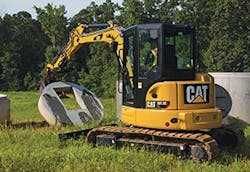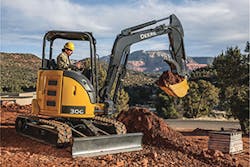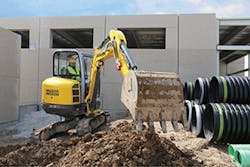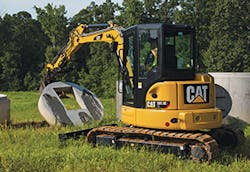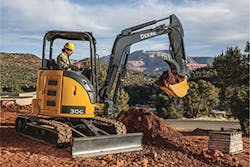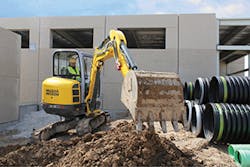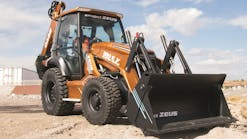Designed to fill the gap left by their full-size counterparts, compact excavators can be—and are—used in a wide variety of applications. “When space is limited or efficiency is the priority, compact excavators can handle any type of excavation job on a smaller scale, including trenching, grading, material handling, and operating attachments,” says Jay Quatro, product application and training specialist at Wacker Neuson Sales Americas, LLC.
Big is in the eye of the beholder, believes Tom Connor, product specialist with Bobcat Company. “Fifteen years ago, we considered compact excavators to be 3,000–7,000 pounds. Now, they can be 2,000–9,000 pounds. Even minis have expanded.” Most draw the line at 8,000–10,000 pounds. he estimates; but “definitively,” if it has a blade and swing boom, it’s a compact.
These small machines can handle some fairly large jobs. They might not be able to complete some jobs as quickly as larger machines, but mini excavators can access places other machines cannot, says Greg Worley, senior project engineer with CAT.
The job capabilities depend on a number of factors, says Brent Kuchynka, vice president of Corporate Fleet at United Rentals. Those factors include the size of the machine, digging depth, site constraints, breakout force, and carrier attachment capacity.
Agility is a major advantage. “Because a mini excavator is more compact than a backhoe or large excavator, it can work in tight spaces,” Kuchynka continues. “It’s less destructive to finished grades and it can also be used for trenching.”
Mini excavators are ideal for getting into tight spaces where larger excavators cannot. Ed Brenton, brand marketing manager at CASE Construction Equipment, points out that they can handle a variety of jobs even on the larger end, such as installing septic tanks and other jobs of that size. “These machines are kind of like a secondary excavator. They’re not going to be running your mainline services; they’re going to be doing more of the floor pits for running communication lines, digging around obstacles, and getting into the tight areas that the big excavators can’t.”
Ultimately, a compact or “mini” excavator is limited only by its dig depth and lifting capacity. “The modern machines are designed to dig every day, all day long, with an increasing emphasis on operator comfort and control,” says Jeff Jacobsmeyer, CE product manager with Kubota Tractor Corporation. Projects from frost footings to water lines can be completed more efficiently with the smaller machines, in comparison with a larger excavator or tractor loader backhoe. As a general rule of thumb, projects requiring a trench 12-feet-deep or less are typically a good fit for compact excavators, he says.
The machines can do a variety of other tasks besides just digging trenches. Mowers, augers, grading buckets, and concrete breakers are just a few examples of what these machines are capable of doing. Mini excavators can handle most jobs on a construction site, provided that the limitations of the excavator are not exceeded. For example, a mini excavator can be used in tight areas for general excavation, for lifting lighter loads, and for operating different attachments, says Eric Berkhimer, product manager of construction equipment with Yanmar American Corporation. “They are easier to transport than larger units, and can be moved easily from site to site, making them very versatile.”
Mobility adds to their versatility. “Compact excavators have a great deal of mobility,” states David Young, product marketing manager, excavators, John Deere. “They may be small, but they’re mighty.” Deere offers a variety of machine sizes to suit most heavy duty applications, from road building to utility work, to landscaping. They can handle job weights anywhere from one metric ton up to six metric tons.
A Cat 305.5E2 CR shows its versatility
There is a wide range of compact excavators available on today’s market, interjects Michael Shebetka, product manager at Takeuchi-US. These range from under two tons to over nine tons and featuring digging depths from six feet to over 15 feet. Many of them feature primary auxiliary hydraulics, secondary auxiliary hydraulics, and in some of the larger compacts, high flow capability. “These features make the excavators ideal for a wide range of attachments,” he says. “You can find these machines working on jobs ranging from demolition, road and bridge work, utility installation, plumbing, landscaping, land clearing, new construction, and pool excavation.”
Compactors and hammers are best suited for heavy industrial needs, Young believes. Compactors can be used to pack the bottom of a pit with materials like grainstone, while hammers can be used for demolition and breaking up concrete.
Operating a John Deere 30G
Job Access
Many applications are suitable for compact excavators, such as landscaping, plumbing and utility work, and indoor demolition, but Quatro points out that they excel in areas where space is limited. “Our 1- to 2-ton models include a retractable undercarriage and a folding dozer blade as standard equipment, allowing the machines greater access into tight spaces on the job site. Also standard are auxiliary hydraulics and fittings. This allows a variety of attachments to be used, including breakers and augers.”
Access is one of the most important advantages of small excavators. “The world and how we work has changed,” CAT’s Worley muses. “Labor is not always available these days, so we need to use machines to replace manual labor. They are far more effective than manual labor.”
Compact excavators are ideal in locations that require a unit to operate in tight quarters. “The Yanmar excavators are either ultra-tight tail models or true zero tail swing models, allowing them to work very closely to existing structures,” says Berkhimer. “For example, the boom swing feature allows the operator to dig right against foundations.” In addition, he says the SV08 and ViO17 models have variable track widths and can fit through a doorway as small as 36 inches, allowing them to work inside a building or a backyard gate.
They definitely are the most sensible when you can’t get your larger machine in or around the job site you’re going to be working on. “I mean, they perform the same way as the larger machines,” Brenton insists. “It’s just a matter of mobility for them.”
Compact excavators are very productive and are found on many of today’s job sites because their size enables them to work in confined and sensitive areas where large machines cannot or will not go, says Shebetka.
There are many job site conditions in which use of a compact excavator makes the most sense. They’re ideal for working in tight spaces, making them popular with contractors who need to work in between large buildings or houses. They’re also perfect for sensitive worksites because of their light footprint, Young explains, adding that customers often choose compact excavators when they need to be mindful of the physical impact they may have on roads or private yards.
Small Advantages
Another important consideration is transportation. These smaller units are also easier to transport than their larger counterparts.
As their name implies, compact excavators can pack a lot of power within a small space, providing advantages that larger machines cannot. “One of their biggest advantages is their ability to be transported easily,” says Deere’s Young. “Because they can be towed behind a large pickup truck or trailer, they can greatly increase a contractor’s mobility, particularly in cities where large trucks are prohibited or where a permit is needed.”
Of course, you have to take into consideration what you are capable of towing, advises Jason Archbold, marketing manager at Bobcat. “Most people try to stay under 10,000 pounds with a trailer. You have to get a CDL for a machine at 8,000 pounds and go through drug screening.”
The most popular compact excavator is the 3–4-metric-ton class due to size and weight, says Jacobsmeyer. “This size of machine is typically the largest compact excavator that can be hauled on a trailer without having to have a commercial driver’s license.” In addition, the compact size causes less collateral damage to the surroundings when performing underground repairs or remodels near existing landscapes or structures.
In relation to transportation to and from the jobsite, Quatro notes. “Compact excavators can be hauled on smaller trailers behind a pickup truck, in most cases. This cuts down on operational costs and reduces the need for special permits [and] commercial licenses.”
Case’s CX37C—a 7,990-pound machine—represents one of the most popular size classes for residential construction applications, Brenton states. “This is a powerful machine with bucket digging forces up to 6,900 pounds of force and over 10 feet of dig depth, but it is still small enough to be towed by a pickup truck. In many states, it can be towed without a CDL.”
Shebetka provides list of advantages of compact excavators:
- They have the ability to get into confined and sensitive areas
- They exert low ground pressure
- They feature auxiliary hydraulics for greater attachment versatility
- They’re easy to haul
- They can dig offset without repositioning the excavator
- They have a backfill blade with float and an angle option for light finish work
- They have low ownership and operation costs
One advantage to note is the ability to work with a variety of attachments through the use of auxiliary hydraulics. “You really get an idea of how versatile mini excavators can be when you look at the variety of attachments that are available for them,” says Brenton. “Not only do you have buckets for standard digging applications, you also have augers, hammers, and plate compactors. These are incredibly versatile machines.”
The versatility of mini excavators resonates with grading and excavation contractors because of the challenges associated with the work. Kuchynka provides an example: “While hydraulic breakers are typically used to break concrete, there’s also a ripper-type bucket that can cut through soil that has a high concentration of rock.”
The smaller machines are excellent if the operator needs to change between different bucket sizes or different working attachments with the use of a quick coupler. Hydraulic quick couplers allow the operator to do this, Berkhimer explains. “The blade equipped as standard can be used to backfill a trench without the need for an additional piece of equipment.”
In addition to their compact size, Case’s C Series mini excavators are available in zero tail swing, short-radius, and conventional configurations, depending on the needs and specifications of the equipment owner. There is also a long-arm option that includes a counterweight. “This is ideal when an operator needs to get more work done without having to reposition the machine,” Brenton explains. They also feature an adjustable boom with the ability to offset left or right to work closer to buildings and obstacles, which is especially helpful when digging along foundations in tight urban areas.
Their smallest model—the CX17C—features a variable-width undercarriage and adjustable blade that is capable of passing through most common gates, in addition to working on confined job sites close to buildings and in developed areas. “Their size makes them ideal machines for a variety of small to mid-sized jobs, like small trench work, digging for sewer line repairs, or irrigations ditches. They are great for a variety of landscaping applications as well—digging ponds and water features, stump removal, etc.—as many compact models are able to access backyards and other residential areas. They are also great machines for demolition work on sheds or other small structures.
The popularity of mini excavators has a lot to do with the fact that they can make a wide range of applications more productive, Kuchynka believes. “Zero tail swing, universal attachments, and quick couplers are all major productivity enhancements.”
To get more out of their machines and increase production, compact excavator owners turn to attachments. With the right attachment, it can become “more than just an excavator,” says Archbold. “People recognize that they can excavate, trench, and do demolition when they have the right attachment.” Bobcat offers rippers, grapples, breakers, compactors, and augers to accomplish different tasks.
A hydraulic thumb is useful for managing the manipulation of irregularly-shaped objects, debris, and rocks. “Kubota’s Hydraulic Thumb Kit continues to be a popular option among our customers because it greatly enhances excavator versatility,” Jacobsmeyer states. Advanced load-sensing hydraulics with an adjustable auxiliary flow allows the operator to dial in the flow rate needed for any attachment.
New coupling designs have dramatically shortened the turnaround time for changing out attachments, which makes it efficient to move from one job to the next. The couplers also improve safety because they reduce the manual labor required to change out attachments.
In 1998, Bobcat introduced Quick Tach. “You can switch in less than one minute without getting off the machine,” says Connor. “Five minutes for hydraulic attachments. It used to take 20–30 minutes to change attachments.”
Working in tight spaces with Wacker Neuson’s EZ38
Similarly, Kubota’s Quick Coupler attachment helps operators change attachments quickly and easily, but they’ve also introduced a new model in the 3–4-ton class. The KX033-4 excavator features a new cab, accepts Quick Coupler attachments, and will be available with an extendable dipper arm by the end of the year.
However, Kuchynka adds, some of the best features are not the attachments themselves, but, rather, the adaptability that has evolved to accommodate different brands of equipment. The majority of attachments used to be manufacturer-specific, he explains. “For example, an attachment would only work with dirt equipment–excavators, backhoes, and skid steers–from the same brand. The innovation of quick couplers with a single pin means that a bucket or attachment can be used on equipment from multiple manufacturers.”
Ltd.
They’re easy to transport, they provide access to tight spaces, they’re easy to operate, they exert low ground pressure, and they’re versatile—particularly through the use of attachments. As Jacobsmeyer says, when properly matched to the project, there really are no limitations to what these machines can do.
Limitations only come into play if you cannot get a big enough machine into a place to meet the requirements of your task, Worley says. “Overall these machines are very flexible. They’re easy to transport, easy to operate, have low ground pressure, and a lot of versatility.”
They do things the big machines can’t do, Connor adds. “Smaller machines take longer to do some jobs, but they have more mobility.” However, eventually you will hit a wall, he admits. “You can’t dig 25-feet-deep or lift heavy items. The smaller machines can’t lift 8,000-pound items.”
Compact excavators may be less suitable for applications that require massive earthmoving capabilities, in which case a medium excavator would be a better fit, Young indicates. Compact excavators also tend to have components that aren’t commonly refurbished, simply because they are less costly than parts in bigger machinery, a consideration that should be factored into a purchasing decision.
Berkhimer agrees: compacted excavators will be limited to jobs requiring heavy or deep digging, high-production applications, and jobs requiring high-lifting capacities—although the availability of additional counterweights may offer some increase.
They are only limited by their digging depth and reach, Quatro confirms. In order to solve this, Wacker Neuson offers standard and long dipper options across their excavator lineup, with the exception of the smallest unit (803).
You must know the job requirements and what you need to accomplish, Connor states. “If you routinely dig 8 feet, a 10-foot machine is borderline. That’s the decision customers make every day. Finding a balance is a moving target.” Some want the smallest machine possible to get the job done, but he says it’s pretty cut and dried: you can’t cheat when digging a given depth. Therefore, don’t buy one rated at the maximum; a bigger machine can do it faster. “Get the biggest machine you can fit.” Ultimately, however, he acknowledges that there’s no such thing as one-size-fits-all. No single machine will work on every job. “That’s why there’s rental.”
Newer features may not be available on older mini excavator models that the contractor already owns, so turning to rental can be a good compromise. The contractor can take advantage of new technologies while continuing to utilize the original capital investment in the older machines.
Telematics
Telematics and machine control are features that will be seen more in compact excavators. Several manufacturers currently offer telematics and some form of machine control as an option. There are also third-party companies that can add machine control to the excavator; this can help keep the system operations consistent if the owner has other brands of machines in a fleet. Kubota’s service access to the hydraulic valve components makes the addition of such a system very easy for the installer, says Jacobsmeyer.
Yanmar excavators come standard with telematics. Machine controls, available through different vendors, can be added to enhance digging efficiency.
All Takeuchi excavators and track loaders come standard with telematics or Takeuchi Fleet Management, with a two-year subscription and a small monthly fee after two years.
Wacker Neuson offers telematics on all of their compact equipment. This allows the owner to not only track the machine’s location, but also monitor hours, time run, battery level, and more. “We are seeing an increased demand in the industry for more robust telematics solutions,” Quatro observes. “As a result, we have stayed on the cutting edge of this technology, and will continue to provide more advanced solutions going forward.”
Increased demand for telematics isn’t surprising. The customer is looking at what’s in full-size machines and wants it in compact equipment, Archbold comments. “It’s evolving technology. Customers are using tracking for a variety of reasons. They want to know the location—and for theft recovery. They want to eliminate grade sticks, which will subsequently reduce manpower and provide more accuracy.”
Technologies from the larger machines are being integrated into the compact sizes because many owners have now seen the benefits, agrees Jacobsmeyer. Manufacturers are taking note.
CAT is “heading in a direction to meet these requirements as the market heads in that direction,” says Worley. “Today we have plug-and-play systems that can be added to the machines. Integrated systems will come in the future.”
All CASE mini excavators come standard from the factory with the prewiring for CASE SiteWatch telematics. While there are currently no integrated machine control technologies available from the factory, these machines are commonly used with “indicate-only” grade control systems.
CASE is strategically partnered with Leica Geosystems to provide and develop machine control systems for CASE equipment, explains Brenton. “In addition to that, we have recently partnered with dealers nationwide to place dedicated ‘precision construction’ specialists in as many dealerships as possible to work with sales staff and customers to better understand how these systems complement the different types of equipment that they are buying, or perhaps already own.”
Deere is another OEM looking at customer demand. “Basic telematics, like GPS monitoring, fuel-efficiency monitoring, and maintenance interval reminders, are becoming more popular amongst compact excavator customers,” notices Young. “We utilize this extensive customer feedback when we look to enhance our current offerings.”
Despite a reluctance of its customers to spend money on depth-guidance systems on smaller machines because the return on investment is less if the machine doesn’t move as much dirt, Connor says that the demand for a depth-guidance system two years ago encouraged them to integrate it into the machine’s control panel. “We got a lot of calls, a lot of demand,” he recalls. Thus, the E32-E55 models now feature Depth Check.
Manufacturers are even starting to look into remote-control applications, says Kuchynka. “Brokk and Husqvarna make remote-controlled, tracked demolition machines with breakers.”
Its size and compatibility with so many attachments make the compact excavator more productive, while telematics adds to its precision and performance.
